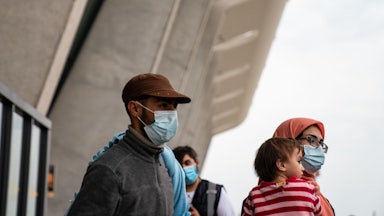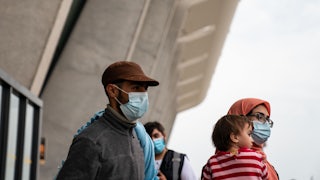One year after the chaotic withdrawal of American troops from Afghanistan, tens of thousands of Afghan evacuees in the United States are suspended in uncertainty without a path to permanent legal residency, while others seeking to enter the country on a humanitarian basis have been stymied by bureaucratic hurdles. But a silver lining emerged on Tuesday with the long-awaited Senate introduction of the Afghan Adjustment Act, which would allow thousands of Afghans in the U.S. to undergo additional vetting to apply for legal residency, and end a period of paralyzing uncertainty concerning their citizenship status.
The legislation was introduced by a bipartisan group: Democratic Senators Amy Klobuchar, Chris Coons, and Richard Blumenthal; and Republican Senators Lindsey Graham, Roy Blunt, and Lisa Murkowski. As with most measures that come to the Senate floor, it will need to garner support from 10 Republicans in order to overcome a filibuster.
The proposed legislation will expand the special immigration visa, or SIV, program to include previously omitted groups which aided the U.S. military, and would establish a task force “to develop and implement a strategy for supporting Afghans outside of the United States who are eligible for SIV status and require the Department of State to respond to congressional inquiries about SIV applications,” according to a press release for the bill. It would also streamline the process for applying for permanent residency. Democratic Representative Earl Blumenauer and Republican Representative Peter Meijer are leading the effort on companion legislation in the House, which also has multiple bipartisan co-sponsors.
“It is unlikely that Afghans brought to the United States on temporary status will be able to return to their homes in the near, mid, or even long-term future. At the same time, there are allies and vulnerable Afghans who are desperately trying to leave their crumbling nation, and who live under great risk,” said Murkowski in a statement. “The United States must ensure that we keep our promises to our Afghan allies, and provide certainty for those who fled to the United States and have no place to return.”
Resettlement organizations and refugee rights groups have urged Congress to pass such a bill. Similar adjustment acts have been passed for Cubans after Fidel Castro’s rise to power, to Southeast Asians after the U.S. withdrawal from Vietnam, and to Iraqis after U.S. military actions in Iraq. “This is how we stand by those who stood by us. Congress has passed similar legislation for every other modern wartime evacuee population, and we simply cannot finish the mission without enshrining these protections into law,” Krish O’Mara Vignarajah, president and CEO of the Lutheran Immigration and Refugee Service, said in a statement.
“This is amazing, let’s hope for the positive outcome,” Khalis Noori, an Afghan evacuee and the director for field operations at a LIRS resettlement facility in northern Virginia, told me in an email on Tuesday afternoon. When I visited the facility in April, Noori told me that passing the Afghan Adjustment Act would mean that “all this burden on our shoulders, the hassle of our clients, and also the uncertainty of the future, will be vanished.”
Lawmakers had been discussing an adjustment act for months. Coons told me last week that he was “optimistic” that it would come together shortly, a prediction which would soon be confirmed. “We’ve had a number of conversations recently to clarify exactly what are the resources, what are the steps, what are the investments, what’s the legal structure that can expedite thorough, in-person vetting for every Afghan who came here through our evacuation, and then what’s the path towards the legal status that would be an appropriate response and incentivize every Afghan who’s here to come forward,” Coons told me.
Several Republicans have raised concerns about the vetting process for accepting evacuated Afghans into the U.S., particularly after a February report by the inspector general for the Defense Department found that evacuees “were not vetted by the National Counter Terrorism Center (NCTC) using all DoD data prior to arriving” in the country. The report found that, of the tens of thousands of evacuees permitted in the country, the National Ground Intelligence Center had “identified 50 Afghan personnel in the United States with information in DoD records that would indicate potentially significant security concerns.”
GOP Senators Josh Hawley and Ron Johnson sent a letter to the inspector general earlier this month revealing new whistleblower allegations that the Biden administration “evacuated 324 individuals from Afghanistan into the United States who appeared on DoD’s watchlist, which includes known suspected terrorists.” FBI Director Christopher Wray told the Senate Judiciary Committee that “there are a number of individuals through our joint-terrorism task forces that we are actively trying to investigate.”
Although the overwhelming majority of Afghans seeking entry into the United States through this process do not represent legitimate security threats, these concerns may have hindered Congress from making meaningful progress on removing roadblocks for these evacuees. Still, Coons told me last week that he believed there was hope for prompt action on an Afghan Adjustment Act: “If it’s going to get done, it’ll get done before the end of this calendar year.” The Senate is currently in recess through the beginning of September.
The U.S. has admitted more than 80,000 Afghans through Operation Allies Welcome since last August. More than 70,000 of these evacuees were admitted through the use of humanitarian parole, bypassing the backlogged asylum process and allowing them to stay in the country for two years. But unlike refugees or recipients of the SIV, parolees in the U.S. do not have an automatic pathway to permanent legal residency. A November report by the Department of Homeland Security found that more than 36,000 of the evacuees in the U.S. have applied for or would be eligible to apply for SIVs, but like the asylum system, the application process for an SIV is lengthy and involved and the system is overwhelmed.
“The U.S. military didn’t just leave Afghanistan, it left hundreds of thousands of Afghan allies behind,” O’Mara Vignarajah told me last week. “When the U.S. left, we left women and girls to fend for their education, and for their very right to exist. We left thousands of families separated by excruciatingly slow bureaucracy. And on top of that, we’ve left tens of thousands of evacuees in a tenuous legal limbo here on American soil.”
Although thousands of Afghans were evacuated last summer, many of them left family in Afghanistan who are now seeking a way to reunite with their loved ones; other allies who worked with the U.S. military have struggled to obtain SIVs. The Biden administration announced a “Priority 2” designation last August to widen the pool of Afghans eligible for relocation to the U.S., but Sunil Varghese, the policy director for the International Refugee Assistance Project, argued to reporters in the press call last week “that program has not been operationalized in any meaningful way.” Many Afghans have thus turned to humanitarian parole instead of waiting on the refugee and SIV process.
But thousands of Afghans seeking to leave Afghanistan through humanitarian parole have not had their applications processed, or have had their requests denied. The situation with potential Afghan parolees presents a stark contrast to the admittance of Ukrainians fleeing their war-torn country in the wake of the Russian invasion. Applications to the dedicated parole program for Ukrainian citizens are free, whereas Afghans seeking parole were initially charged an application fee.
But a DHS spokesperson noted that the agency announced in November that it would exempt filing fees and “streamline application processing” for Afghan nationals paroled into the U.S. on a humanitarian basis on or after July 31, 2021.
“These actions will help facilitate their resettlement in the U.S. by streamlining the processing of requests for work authorization, Green Cards, and associated services,” a DHS spokesperson said in a statement. The spokesperson added that the U.S. is “prepared to welcome additional Afghans over the coming weeks and months, including those who are at overseas transit locations awaiting clearance to come to the United States.”
The process for Ukrainian citizens has further been streamlined to avoid the long wait times experienced by other parole applicants. The U.S. Customs and Immigration Services says that it cannot process the parole applications of Afghans in Afghanistan, because there is no longer an American consulate presence in the country; meanwhile, the Biden administration excluded the consular processing requirement for Ukrainians seeking parole. Roughly 70 percent of pending humanitarian parole applications are for Afghans currently in Afghanistan, according to DHS.
“For Afghans, the lack of a consular presence in Afghanistan and the interminably long vetting process are being relied on to leave Afghan parole applications pending—even though we know those obstacles can be overcome given that they were streamlined in the Ukrainian context,” Varghese said. “If the U.S. government was inclined to do so, it could fix many of these issues.”
The U.S. has received more than 100,000 Ukrainians since February, including around 22,000 granted parole crossing the U.S.-Mexico border, and roughly 30,000 admitted through the dedicated parole program, Uniting for Ukraine. As of July 1, USCIS has received 48,000 requests for humanitarian parole from Afghan nationals, and has denied 8,000. Around 369 Afghan nationals outside the U.S. have been conditionally approved for humanitarian parole as of July 28, according to a DHS spokesperson. A notice on the USCIS website informs potential Afghan applicants that the current processing time for parole requests exceeds 90 days, and says that “parole is not intended to replace established refugee processing channels.”
“The Biden administration should be commended for the goals and actions that it has taken to bring Ukrainians to safety. While we raised concerns on that response, and ways it could have been improved, it should serve as a proof point that the U.S. government can take urgent action when there’s a humanitarian imperative,” O’Mara Vignarajah told me last week. “But we want to see that across the board. I think it’s fair to say that Afghans with pending family reunification applications have felt like they have fallen by the wayside. And our point is, it shouldn’t be a competition.”
In the press call last week, Chris Purdy, the director of Veterans for American Ideals and Outreach at Human Rights First, outlined three ways in which the American government could continue to aid Afghans: Pass and have President Joe Biden sign the Afghan Adjustment Act, create more pathways for Afghans to enter the U.S., and streamline the application and resettlement processes. “We must help every Afghan who needs assistance quickly, efficiently without delay. Their lives are depending on it,” Purdy said.
In a statement released after the introduction after the Afghan Adjustment Act, Varghese reiterated, “We once again remind the U.S. government of its promise and obligation to provide pathways to safety for the too many vulnerable Afghans left behind.”
However belatedly, with the revival of this bipartisan measure, Congress is beginning to address the consequences of two decades years of conflict followed by a traumatizing evacuation process. “We owe an enormous debt of gratitude to the Afghan people for the ways they supported U.S. forces for almost 20 years, often at great personal risk,” Coons said in a statement on Tuesday. “The introduction of the Afghan Adjustment Act is a first step towards keeping our word as a nation and honoring that debt.”










